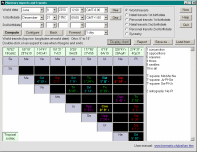| January 10, 2026, 12:00 GMT Julian date: 2,461,051.00 | ||||
| Ecliptic longitudes | ||||
| Planet | Geocentric | Heliocentric | ||
| Sun | 290°15' | 20Cap15 | ||
| Mercury | 283°25' | 13Cap25 | 268°49' | 28Sag49 |
| Venus | 291°9' | 21Cap9 | 292°24' | 22Cap24 |
| Earth | 110°15' | 20Can15 | ||
| Mars | 290°0' | 20Cap0 | 289°50' | 19Cap50 |
| Jupiter | 110°5' | 20Can5 | 110°7' | 20Can7 |
| Saturn | 356°47' | 26Pis47 | 2°14' | 2Ari14 |
| Uranus | 57°43' | 27Tau43 | 60°1' | 0Gem1 |
| Neptune | 359°39' | 29Pis39 | 1°25' | 1Ari25 |
| Pluto | 303°0' | 3Aqu0 | 303°22' | 3Aqu22 |
| Moon | 198°29' | 18Lib29 | ||
Please visit our Software Shop to see software available.
The programs on this website are based on exact astronomical algorithms developed by astronomers. They are mostly described here as if they were merely astrological, but they are also useful in the areas of astro‑trading and astronomy.
The position of a planet in the geocentric zodiac is not significantly affected by the location on the Earth from which the planet is observed. The zodiac positions of the planets are based on their positions relative to the fixed background of the stars and are not influenced by the observer's location on the Earth. The apparent motion of the planets, including (in the geocentric zodiac) retrograde motion, is a result of the Earth's movement and the relative positions of the planets in our solar system. Therefore, the position of a planet in the geocentric zodiac is not dependent on the observer's location on Earth. Thus the calculations on this website do not depend on the location of a hypothetical observer on the Earth.
In geocentric astrology the solar system and the zodiac are viewed from the perspective of the Earth, whereas in heliocentric astrology they are viewed from the perspective of the Sun. Most astrological software is geocentric, but astro‑trading programs often use a heliocentric zodiac.
What's a planetary transit?
Planetary aspects occur when two planets possess a particular angular relationship with each other (e.g. conjunction, opposition, trine, square, etc.) with respect to a central point. This point is either the Earth (in geocentric astrology) or the Sun (in heliocentric astrology). A planetary transit is the period during which two planets remain continuously in a particular aspect with each other.
The programs described here either display planetary aspects and transits or calculate the exact dates and times at which transits occur (begin and end) between selected planets. Click on any of the program titles or screenshots for more information about a particular program (and the user manual). Or to get short descriptions of these programs visit our software shop.

Astrology without houses
The reason that none of these four programs involve an ascendant, or astrological houses, is that the ascendant (and thus any house system) depends on a geographical position (usually a birthplace). But aspects between planets, and thus planetary transits, depend only on the motion of the planets along the ecliptic as viewed from the Earth (or the Sun). Thus a planetary transit does not require, or imply, an ascendant (and thus no house system). Aspects and transits have their own astrological meaning. (Yes, astrology without houses is possible.) Signs (derived from the equal division of the ecliptic) are as usual, for example, Neptune is in Pisces from April 4, 2011, through March 30, 2025; and see this Su‑Me‑Sa‑Pl 4‑stellium in Capricorn on January 12, 2020). For a heliocentric example see this double kite.
There are 7 house systems commonly used by astrologers, and over 20 are possible. They give different results when interpreting a horoscope (and the Koch and Placidus systems don't even work for all latitudes). Which gives the "correct" interpretation? Or should we just conclude that the "meanings" given to houses are (arbitrary?) choices made by astrologers long ago, uncritically passed from generation to generation, and that only aspects (especially aspect patterns) and transits are important (and still to be properly interpreted)?
Please visit our Software Shop to see software available.









